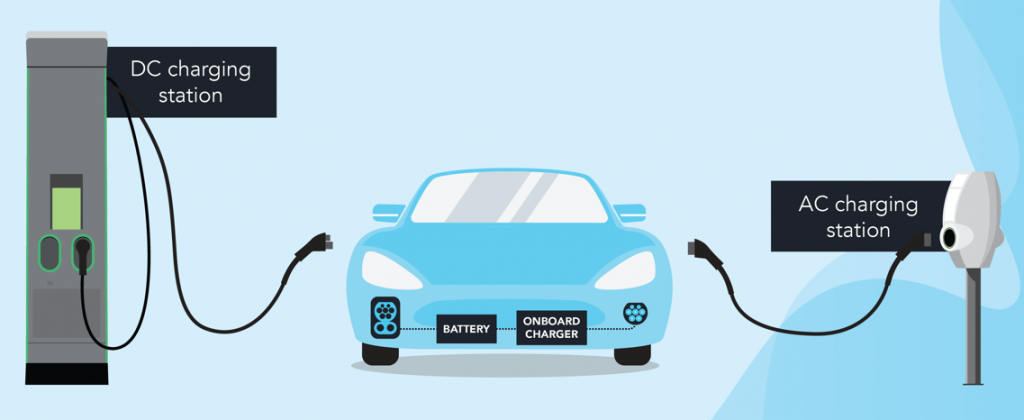When discussing charging methods for electric vehicles (EVs), there are two different current types to choose from: alternating current (AC) and direct current (DC).
The core difference between the two charging methods is where the current is converted: AC charging converts AC to DC inside the vehicle, while DC charging completes this conversion at the charging station. This article explores the differences between AC and DC EV charging in detail.
What is AC Charging?

AC charging is a method of charging electric vehicles (EVs) by converting alternating current from the grid into direct current (DC) power that can be stored in the vehicle’s battery. This charging method can utilize the existing power structure of the home or office and is easy to install and use.
The main advantages of AC charging are low cost and easy installation. It is generally suitable for low-peak power consumption at night. However, its disadvantage is that the charging speed is slow, and it usually takes 6-12 hours or even longer to be fully charged, which limits its application in situations where fast charging is required.
What is DC Charging?

DC charging can transfer electrical energy directly to the vehicle’s battery in the form of direct current, thereby greatly shortening charging time. Allows batteries to be recharged to 80% or more in less time, typically just 30 minutes.
The advantage of this method is that it can be charged quickly, which is especially suitable for occasions where quick replenishment of energy is required, such as fast charging stations on road trips. However, disadvantages include higher charging infrastructure costs and higher load requirements on the grid.
What Is the Difference Between AC Charging and DC Charging?

Alternating current charging (AC) and direct current charging (DC) are the two main methods of charging electric vehicles. They differ in usage scenarios, costs, charging efficiency and charging curves.
Scenes to Be Used
AC charging is typically used at home or in the workplace because it works directly from a regular household electrical outlet. This method is suitable for long-term charging at night.
DC charging is commonly found in highway service areas or specialized charging stations and is suitable for situations where fast charging is required, such as quick replenishment of power during long journeys.
Cost
AC charging has lower equipment and installation costs, typically between $250 and $4,500, because they are relatively simple technology and can leverage existing electrical infrastructure.
DC charging facilities are more expensive, typically between $10,000 and $140,000, and require more sophisticated technology to manage high-power currents and voltages, significantly increasing construction and maintenance costs.
Charging Efficiency
AC charging is relatively inefficient because electrical energy needs to be converted from alternating current to direct current through a converter inside the vehicle, and there is energy loss in this process.
DC charging directly provides direct current to the electric vehicle’s battery, reducing energy loss during the conversion process and therefore charging more efficiently.
Electric Vehicle Charging Curve
The charging curve of AC charging is usually linear, with the charging speed gradually slowing down as the charging time increases, especially when the battery is close to full charge. It usually takes 8-12 hours or even longer to fully charge the car.
DC charging provides fast charging in the early stage, which can charge the battery to about 80% in about 30 minutes. After that, in order to protect the health of the battery, the charging speed will decrease significantly.
AC VS DC Charging Service Life
The battery life of electric vehicles is affected by charging frequency, charging speed, efficiency of the battery management system, and the temperature of the usage environment.
If only AC charging is used, the battery life may be between 8-15 years, depending on the type and quality of the battery, and the effectiveness of the battery management system.
Frequent use of DC fast charging may shorten battery life because the high temperatures generated during fast charging may damage the battery’s chemical structure. So its lifespan may be reduced to 5-8 years.
AC VS DC Charging Table Comparison
| Aspect | AC Charging | DC Charging |
| Conversion Location | Conversion from AC to DC inside the vehicle | Conversion happens at the charging station |
| Common Usage | Home charging, public chargers | Fast charging stations |
| Speed | Slower, suitable for overnight charging | Faster, suitable for quick top-ups |
| Cost | Generally lower cost of equipment and setup | Higher cost due to complex infrastructure |
| Infrastructure | Widely available, simpler technology | Less common, requires more advanced technology |
| Energy Efficiency | Lower due to conversion losses | Higher due to direct DC supply |
| Battery Impact | Gentle on battery life | Can reduce battery life if used frequently |
| Typical Power Output | 3 kW to 22 kW | Up to 350 kW or more |
Conclusion
Through this article, we learned that AC charging is cheap and easy to install. Widely used in homes and public places, suitable for daily low-speed charging. DC charging is more expensive but provides fast charging capabilities, which is especially suitable for fast charging needs during long-distance travel.
To choose the right electric vehicle charger for your application needs, you can find the right charger for you on the MOREDAY website.
Frequently Asked Questions
1. How long do electric car batteries last?
Electric vehicle (EV) battery life is often affected by battery type, usage and charging habits, and overall vehicle maintenance. The battery life of most modern electric cars is about 8 to 15 years.
2. Does Tesla charge AC or DC?
Tesla vehicles are capable of charging using both AC and DC power sources. For regular home charging, Tesla uses alternating current, which the car’s onboard charger converts to direct current to charge the battery. To enable fast charging on the move, Tesla leverages its Supercharger network to provide high-speed DC charging directly to vehicles, bypassing on-board chargers for faster energy transfer.
3. Are level 2 chargers AC or DC?
Level 2 chargers use alternating current (AC). This type of charger is generally used in homes or public charging places and can provide faster charging than Level 1 chargers. Level 2 chargers typically require a 240-volt power source and are capable of delivering higher power to electric vehicles, resulting in faster charging times.
Related reading: Level 1 vs level 2 vs level 3 EV charger


